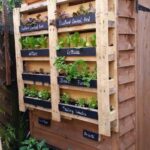Gardening on sloped terrain presents a unique set of challenges and opportunities for creating a stunning and functional outdoor space. Whether you have a gently sloping hillside or a steep incline, there are numerous garden ideas for sloped gardens that can help you transform your landscape into a beautiful and thriving oasis. From terracing techniques to plant selection and erosion control, this article will provide valuable insights and practical tips for making the most of your sloped garden.
One of the biggest challenges of gardening on a slope is creating level areas that are both visually appealing and usable. Terracing techniques play a crucial role in achieving this, allowing you to create multiple flat spaces on different levels of the slope.
In addition to terracing, careful consideration must be given to plant selection, as not all plants thrive in sloped conditions. Erosion control is another important aspect to consider, as heavy rainfall or watering can lead to soil erosion on sloped terrain.
In this article, we will delve into various aspects of gardening on sloped terrain, including vertical gardening solutions, water management, access and pathways, and design inspiration. By understanding the unique challenges and opportunities that come with gardening on slopes, you can unlock the potential of your outdoor space and create a stunning garden that thrives in its natural environment.
Terracing Techniques
Terracing is one of the most effective techniques for creating level areas on a sloped garden. This method involves constructing a series of flat platforms or steps, which not only helps to prevent soil erosion but also provides new opportunities for planting and landscaping. There are several different terracing options to consider, including natural stone retaining walls, timber sleeper retaining walls, or even simple mounded earth terraces.
One popular terracing technique is the use of dry-stacked stones or bricks to build retaining walls that hold back the soil and create level areas for gardening. This not only adds a visually appealing element to your garden but also serves a functional purpose in preventing soil runoff.
For those looking for a more natural and rustic look, timber sleeper retaining walls are a great option. These can be easily installed and provide an attractive and durable solution for creating terraced levels.
When considering how to create level areas on your sloped garden, it’s important to take into account the overall design aesthetic you want to achieve as well as the practical aspects of maintaining these terraced areas. With some careful planning and the right materials, you can transform your sloped garden into a beautiful and functional space that showcases your favorite plants and landscape features.
| Terracing Techniques | How to Create Level Areas on a Sloped Garden |
|---|---|
| Terracing with dry-stacked stones or bricks | This method adds visual appeal while preventing soil erosion. |
| Timber sleeper retaining walls | A natural and rustic option for creating terraced levels in a sloped garden. |
Plant Selection
Planting on a sloped garden can present unique challenges, but with the right plant selection, it can also be an opportunity to create an eye-catching and dynamic landscape. When choosing plants for a sloped garden, it’s important to consider factors such as soil erosion, water retention, and sunlight exposure. Here are some key considerations and plant options to keep in mind when selecting vegetation for your sloped garden.
Considerations for Plant Selection
When deciding which plants to include in your sloped garden, it’s essential to consider how they will interact with the slope. Plants with shallow root systems and those that are drought-tolerant are ideal for sloping terrain as they can help prevent soil erosion and retain moisture. Additionally, selecting plants that offer various heights, textures, and colors can enhance the visual appeal of the garden while also providing stability and balance on the slope.
Plant Options for Sloped Gardens
Ground covers such as creeping thyme or ivy are excellent choices for sloped gardens as they spread easily, creating a natural barrier against erosion. Shrubs like juniper or lavender can also thrive on a slope while adding color and fragrance to the landscape.
When it comes to trees, opt for those with strong root systems like oak or maple to anchor the soil. Perennials such as yarrow or sedum are great additions to a sloped garden as they require minimal maintenance and provide long-lasting beauty.
Maintenance and Care
After selecting the right plants for your sloped garden, it’s important to establish a regular maintenance routine. Proper watering is crucial, especially on slopes where water runoff may occur more rapidly. Mulching around plants can help retain moisture and prevent erosion. Additionally, regularly inspecting the soil for signs of erosion or instability is vital in maintaining a healthy and thriving slope garden landscape.
By carefully considering these plant selection tips along with innovative solutions like terracing techniques and vertical gardening possibilities (as discussed in other sections of this article), you can transform any challenging slope into a stunning and vibrant garden space that adds character to your outdoor environment.
Erosion Control
Soil erosion is a common challenge in sloped gardens, but there are several effective strategies for preventing this issue and maintaining the integrity of your landscape. Here are some practical techniques to consider:
1. Ground cover plants: One of the most natural and visually appealing ways to prevent soil erosion on a slope is by planting ground cover vegetation. These low-growing plants help stabilize the soil with their roots and reduce the impact of rainwater runoff. Some excellent options for ground cover plants include creeping juniper, thyme, sedum, and vinca.
2. Mulching: Applying a layer of mulch to the soil surface can significantly reduce erosion by protecting the soil from the impact of heavy rain and preventing water runoff. Organic mulches like wood chips, straw, and shredded bark not only help control erosion but also improve soil moisture retention and temperature regulation.
3. Retaining walls: Constructing retaining walls is another effective way to prevent soil erosion on a slope. These structures hold back the soil, creating terraced levels that minimize the risk of runoff and allow for more stable planting areas. Natural stone, timber, or concrete blocks can be used to build retaining walls that blend seamlessly with the landscape.
By implementing these erosion control strategies in your sloped garden design, you can maintain a healthy environment for your plants while preserving the beauty of your outdoor space.
Access and Pathways
Creating pathways in a sloped garden can be both challenging and rewarding. It allows for not only functional access throughout the landscape but also adds visual interest and structure to the overall design. Here are some garden ideas for sloped gardens to consider when creating pathways in your own sloped garden:
1. Switchback Path: To navigate a steep slope, consider creating a switchback path that zigzags its way up or down the incline. This not only makes it easier to traverse the terrain but also creates a visually appealing pattern within the garden.
2. Stepping Stones: Incorporating stepping stones into the garden design not only provides practical passage through the space but also adds an element of charm and whimsy. Choose natural stone or pavers that complement the style of your garden for a cohesive look.
3. Elevated Walkway: For particularly steep slopes, consider installing an elevated walkway that offers a level pathway through the space. This can be constructed using materials such as wood or composite decking to create a durable and visually striking feature.
In addition to these ideas, it’s important to ensure that any pathways in a sloped garden are properly graded and have adequate drainage to prevent erosion and water buildup. By carefully planning out and implementing these garden ideas for sloped gardens, you can create functional and visually appealing pathways that enhance the beauty of your landscape while providing easy access throughout.
Vertical Gardening
When it comes to gardening on sloped terrain, one of the most effective and visually appealing solutions is vertical gardening. This technique allows you to maximize space and create a stunning visual impact in your sloped garden. Whether you have a small or large slope, vertical gardening can be a game-changer in transforming the aesthetics of your outdoor space.
Vertical Planters and Trellises
One popular approach to vertical gardening in sloped gardens is the use of vertical planters and trellises. These structures not only provide support for climbing plants but also create a beautiful accent on the slope. You can grow a variety of flowers, herbs, or even vegetables in these vertical structures, adding both functionality and beauty to your garden.
Hanging Gardens
Another fantastic way to utilize vertical space in a sloped garden is by creating hanging gardens. By suspending planter boxes or baskets from elevated points on the slope, you can add layers of greenery that cascade down, creating a stunning waterfall effect of plants. Hanging gardens are not only visually striking but also provide excellent air circulation for the plants, promoting healthy growth.
Living Walls
For those looking to make a bold statement with their sloped garden, living walls are an incredible option. These vertical gardens consist of modular panels filled with plants, creating a lush tapestry that covers the slope. Living walls offer endless possibilities for plant selection and design, allowing you to customize the look and feel of your garden while maximizing space on the slope.
Incorporating these vertical gardening solutions into your sloped garden can transform it into a dynamic and vibrant outdoor space while providing added functionality and visual interest. With careful planning and creativity, you can turn your challenging landscape into a stunning oasis that showcases the beauty of nature amidst its unique topography.
Water Management
Watering a sloped garden can be a challenge due to the uneven terrain and potential for water runoff. However, there are several tips for effectively managing water in a sloped garden to ensure that your plants receive the proper hydration they need to thrive.
One effective technique is the use of drip irrigation systems, which deliver water directly to the base of plants, minimizing runoff and ensuring efficient absorption. Additionally, mulching can help retain moisture in the soil and prevent erosion on sloped gardens.
Another important aspect of water management in sloped gardens is grading and shaping the landscape to control water flow. By creating channels or swales, you can direct water where it is needed most and prevent excessive runoff that can lead to erosion. It’s also essential to monitor how water flows through your garden during heavy rainfall and make necessary adjustments to prevent soil saturation or flooding.
Furthermore, consider incorporating rain barrels or other water collection systems into your sloped garden design. Collecting rainwater not only helps conserve water but also provides a sustainable source of irrigation for your garden. With these strategies and careful planning, you can effectively manage water in your sloped garden to promote healthy plant growth and minimize erosion.
| Water Management Tips | Description |
|---|---|
| Drip Irrigation Systems | Deliver water directly to plants’ base |
| Grading and Shaping Landscape | Create channels or swales to control water flow |
| Rainwater Collection Systems | Use rain barrels to collect and reuse water for irrigation |
Design Inspiration
When it comes to designing a sloped garden, creativity and practicality are key. One of the most effective ways to make the most of a sloped landscape is by incorporating terracing techniques. Creating levels within the slope not only adds visual interest but also makes the garden more functional. Terracing can be achieved using various materials such as wood, stone, or even retaining walls. This allows for different areas to be utilized for planting, relaxation, and entertaining.
In addition to terracing, vertical gardening can also make a significant impact on a sloped garden. By using trellises, hanging planters, or wall-mounted containers, you can maximize space and create a stunning visual display. This technique not only adds beauty but also provides an opportunity to grow a wider variety of plants in a limited space.
Another important aspect of designing a sloped garden is incorporating pathways that are both functional and visually appealing. Switchback pathways not only provide easy access to different levels of the garden but also add an element of intrigue and charm. Using natural materials such as gravel or stepping stones can help blend the pathways seamlessly into the landscape while preventing erosion.
Conclusion
In conclusion, gardening on sloped terrain may present unique challenges, but with the right techniques and strategies, it can also offer stunning opportunities for creative landscaping and design. By utilizing terracing techniques to create level areas, carefully selecting appropriate plants, implementing erosion control measures, and incorporating functional pathways and vertical gardening solutions, a sloped garden can be transformed into a beautiful and functional outdoor space.
Effective water management is crucial for the success of a sloped garden, ensuring that plants receive adequate hydration while minimizing soil erosion. By implementing water-saving techniques such as drip irrigation or installing rain gardens, gardeners can maintain a healthy and sustainable landscape.
Ultimately, embracing the beauty of sloped gardens requires creativity, patience, and an open mind. Whether it’s creating a series of terraced plant beds filled with colorful blooms or establishing a cascading waterfall feature down a hillside, the possibilities are endless. With the right garden ideas for sloped gardens and a willingness to explore innovative solutions, anyone can turn their challenging slope into a breathtaking outdoor oasis.

Welcome to my gardening blog! I am passionate about plants and enjoy sharing my knowledge and experiences with others. In this blog, I will write about everything related to gardening, from tips on how to get started to updates on my own garden projects.





